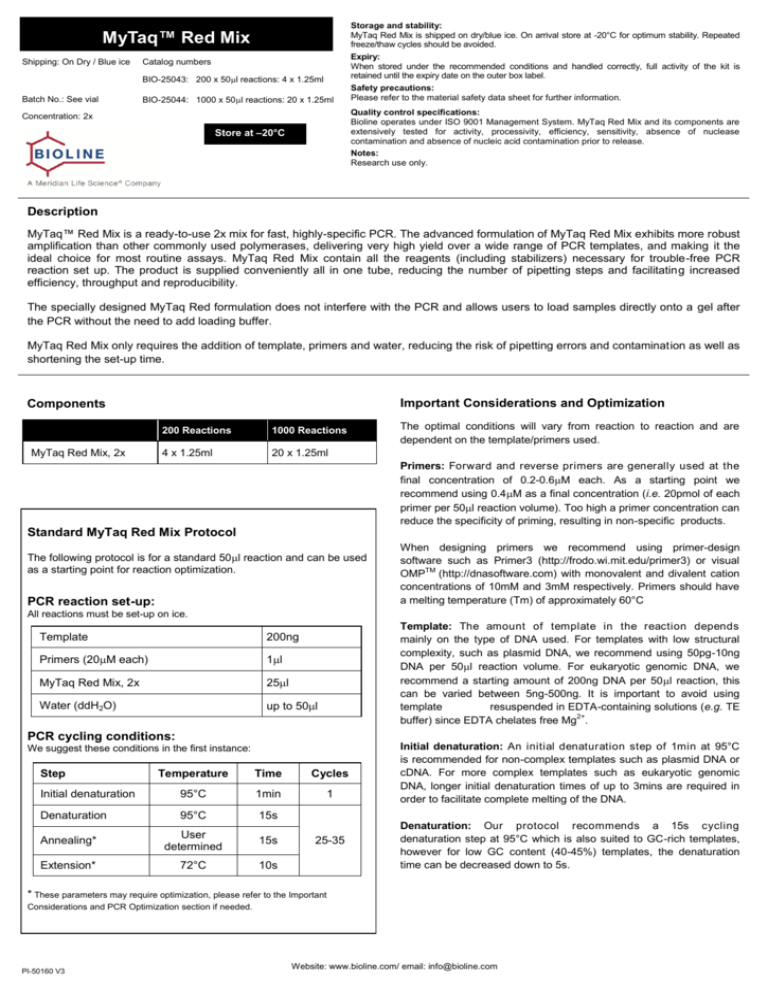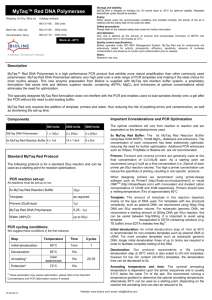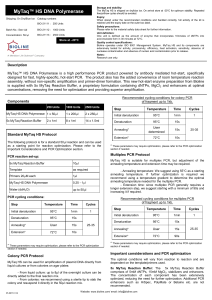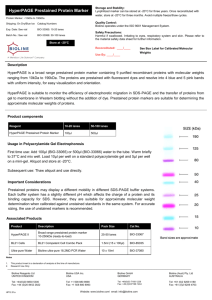MyTaq™ Red Mix
advertisement

MyTaq™ Red Mix Shipping: On Dry / Blue ice Catalog numbers BIO-25043: 200 x 50l reactions: 4 x 1.25ml Batch No.: See vial BIO-25044: 1000 x 50l reactions: 20 x 1.25ml Storage and stability: MyTaq Red Mix is shipped on dry/blue ice. On arrival store at -20°C for optimum stability. Repeated freeze/thaw cycles should be avoided. Expiry: When stored under the recommended conditions and handled correctly, full activity of the kit is retained until the expiry date on the outer box label. Safety precautions: Please refer to the material safety data sheet for further information. Quality control specifications: Bioline operates under ISO 9001 Management System. MyTaq Red Mix and its components are extensively tested for activity, processivity, efficiency, sensitivity, absence of nuclease contamination and absence of nucleic acid contamination prior to release. Notes: Research use only. Concentration: 2x Store at –20°C Description MyTaq™ Red Mix is a ready-to-use 2x mix for fast, highly-specific PCR. The advanced formulation of MyTaq Red Mix exhibits more robust amplification than other commonly used polymerases, delivering very high yield over a wide range of PCR templates, and making it the ideal choice for most routine assays. MyTaq Red Mix contain all the reagents (including stabilizers) necessary for trouble-free PCR reaction set up. The product is supplied conveniently all in one tube, reducing the number of pipetting steps and facilitating increased efficiency, throughput and reproducibility. The specially designed MyTaq Red formulation does not interfere with the PCR and allows users to load samples directly onto a gel after the PCR without the need to add loading buffer. MyTaq Red Mix only requires the addition of template, primers and water, reducing the risk of pipetting errors and contamination as well as shortening the set-up time. Important Considerations and Optimization Components MyTaq Red Mix, 2x 200 Reactions 1000 Reactions 4 x 1.25ml 20 x 1.25ml The optimal conditions will vary from reaction to reaction and are dependent on the template/primers used. Primers: Forward and reverse primers are generally used at the final concentration of 0.2-0.6M each. As a starting point we recommend using 0.4M as a final concentration (i.e. 20pmol of each primer per 50l reaction volume). Too high a primer concentration can reduce the specificity of priming, resulting in non-specific products. Standard MyTaq Red Mix Protocol The following protocol is for a standard 50l reaction and can be used as a starting point for reaction optimization. PCR reaction set-up: When designing primers we recommend using primer-design software such as Primer3 (http://frodo.wi.mit.edu/primer3) or visual OMPTM (http://dnasoftware.com) with monovalent and divalent cation concentrations of 10mM and 3mM respectively. Primers should have a melting temperature (Tm) of approximately 60°C All reactions must be set-up on ice. Template 200ng Primers (20M each) 1l MyTaq Red Mix, 2x 25l Water (ddH2O) up to 50l Template: The amount of template in the reaction depends mainly on the type of DNA used. For templates with low structural complexity, such as plasmid DNA, we recommend using 50pg-10ng DNA per 50l reaction volume. For eukaryotic genomic DNA, we recommend a starting amount of 200ng DNA per 50l reaction, this can be varied between 5ng-500ng. It is important to avoid using template resuspended in EDTA-containing solutions (e.g. TE buffer) since EDTA chelates free Mg2+. PCR cycling conditions: We suggest these conditions in the first instance: Step Temperature Time Cycles Initial denaturation 95°C 1min 1 Denaturation 95°C 15s Annealing* User determined 15s Extension* 72°C 10s 25-35 Initial denaturation: An initial denaturation step of 1min at 95°C is recommended for non-complex templates such as plasmid DNA or cDNA. For more complex templates such as eukaryotic genomic DNA, longer initial denaturation times of up to 3mins are required in order to facilitate complete melting of the DNA. Denaturation: Our protocol recommends a 15s cycling denaturation step at 95°C which is also suited to GC-rich templates, however for low GC content (40-45%) templates, the denaturation time can be decreased down to 5s. * These parameters may require optimization, please refer to the Important Considerations and PCR Optimization section if needed. PI-50160 V3 Website: www.bioline.com/ email: info@bioline.com Annealing temperature and time: The optimal annealing temperature is dependent upon the primer sequences and is usually 2-5°C below the lower Tm of the pair. We recommend running a temperature gradient to determine the optimal annealing temperature, alternatively 55°C can be used as a starting point. Depending on the reaction the annealing time can also be reduced to 5s. Extension temperature and time: The extension step should be performed at 72°C. The extension time depends on the length of the amplicon and the complexity of the template. For low complexity template such as plasmid DNA, an extension time of 10s is sufficient for amplicons under 1kb or up to 5kb. For amplification of fragments over 1kb from high complexity template, such as eukaryotic genomic DNA, longer extension times are recommended. In order to find the fastest optimal condition, we suggest incrementing the extension time successively up to 30s/kb. Troubleshooting Guide Problem Possible Cause Recommendation Missing component - Check reaction set-up and volumes used Defective component - Check the aspect and the concentrations of all components as well as the storage conditions. If necessary test each component individually in controlled reactions Cycling conditions not optimal - Difficult template - Increase the denaturation time Excessive cycling - Decrease the number of cycles Extension time too long - Decrease the extension time Annealing temperature too low - Increase the annealing temperature Primer concentration too high - Decrease primer concentration Extension during set-up - Make sure all reactions are set-up on ice. Run reaction as quickly as possible Contamination - Replace each component in order to find the possible source of contamination - Setup the PCR and analyze the PCR product in separated areas No PCR product Smearing Decrease the annealing temperature Run a temperature gradient to determine the optimal annealing temperature Increase the extension time, especially if amplifying a long target Increase the number of cycles or Non-Specific products Associated Products Technical Support If the troubleshooting guide does not solve the difficulty you are experiencing, please contact your local distributor or our Technical Support with details of reaction set-up, cycling conditions and relevant data. Email: tech@bioline.com Product Name Pack Size Cat No Agarose 500g BIO-41025 Agarose tablets 300g BIO-41027 HyperLadder™ 1kb 200 Lanes BIO-33025 SureClean Plus 1 x 5ml BIO-37047 TRADEMARKS 1. MyTaq and HyperLadder are Trademarks of Bioline Reagents Ltd ____________________________________________________________________________________________________________________________ Bioline Reagents Ltd UNITED KINGDOM Bioline USA Inc. USA Bioline GmbH GERMANY Bioline (Aust) Pty. Ltd AUSTRALIA Bioline France FRANCE Meridian Bioscience Asia Pte Ltd SINGAPORE Tel: +44 (0)20 8830 5300 Fax: +44 (0)20 8452 2822 Tel: +1 508 880 8990 Fax: +1 508 880 8993 Tel: +49 (0)337 168 1229 Fax: +49 (0)3371 68 1244 Tel: +61 (0)2 9209 4180 Fax: +61 (0)2 9209 4763 Tel: +33 (0)1 42 56 04 40 Fax: +33 (0)9 70 06 62 10 Tel: +65 6774 7196 Fax: +65 6774 6441 PI-501460 V3 Website: www.bioline.com/ email: info@bioline.com









